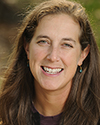 Naomi E. Levin |
2013 Young Scientist Award (Donath Medal)
Presented to Naomi E. Levin
Citation by Thure E. Cerling
Naomi Levin has made outstanding contributions to understanding the environments of human origins in Africa. She has done extensive field work in the Awash region of Ethiopia, and in the Omo-Turkana Basin in Ethiopia and Kenya: these basins have yielded most of the dated hominin fossils in Africa older than 1 Myr. One the greatest of controversies in human evolution has to do with the environments in which humans evolved, particularly the early period when the earliest clear human ancestors arose – the Australopithecines – about 4 million years ago. She contributed to the understanding of environments through her careful stratigraphic studies and her stable isotope work on fossil soils and fossil tooth enamel. She is a welcome addition to any field party because of her scientific abilities, collegiality, and positive approach to problems, whether challenging or routine. Her lab work has opened new ways of quantifying environmental parameters – stable isotopes as absolute indicators of paleoaridity, paleodiet, and paleotemperature.
Naomi has the qualities of a future leader in the earth science – prowess in both field and laboratory science, courage in meeting controversy with reason and diplomacy, and passion for educating new generations of earth scientists.
 2013 Donath Medal — Response by Naomi E. Levin
2013 Donath Medal — Response by Naomi E. Levin
Thank you Thure. I foremost want to thank GSA and Dr. and Mrs. Fred Donath for the creation and support of this award. I am very honored to receive it.
I feel like the best way to accept this award is to share it with the community of mentors and colleagues who have shaped me both as a scientist and a person.
Within this community, Thure Cerling and Jay Quade have been some of my biggest influences. Jay introduced me to working in eastern Africa but more importantly he taught me to study a system from the ground up: roll up my sleeves, walk back to that outcrop again, and figure it out. No system seems off limits with Jay– just buckle up and study it, thoroughly. Working with Thure broadened the scope my research to elsewhere in eastern Africa and to include the ecology and climate of modern systems. Thure’s tenacity is hard to keep up with, but through it he has taught me to think big, be creative and invest in long-term efforts. Both Jay and Thure have been huge models for how I work with colleagues and bridge disciplines.
I have been lucky to have worked with many people who have given me opportunities and challenged me. Among them, I thank Frank Brown, Kay Behrensmeyer, Scott Simpson, and Dave Braun for their strong influences on my field work. Both Jim Ehleringer and Ed Zipser at the Univeristy of Utah enabled me to work on modern systems. And I thank John Eiler for a quick but very influential postdoc at Caltech that introduced me to an entirely different approach to isotope geochemistry.
I am also grateful for the colleagues and culture at Johns Hopkins. It’s a place where I am supported and trusted to do the kind of work that I find most interesting while also stretched to think beyond my intellectual comfort zone.
I am indebted to my parents, Carol and Jack, and my brother Daniel who have encouraged me to pursue my interests and gave me opportunities to explore. They continue to instill in me the importance of hard work, passion and curiosity.
And of course I have another reason to thank Thure. He was able to convince Ben Passey to stay at the U of U for a PhD, enabling Ben to be my lab mate when I arrived and now my husband. Ben is my best colleague and my best friend. I can’t imagine being here without him.
Thank you again to GSA.
